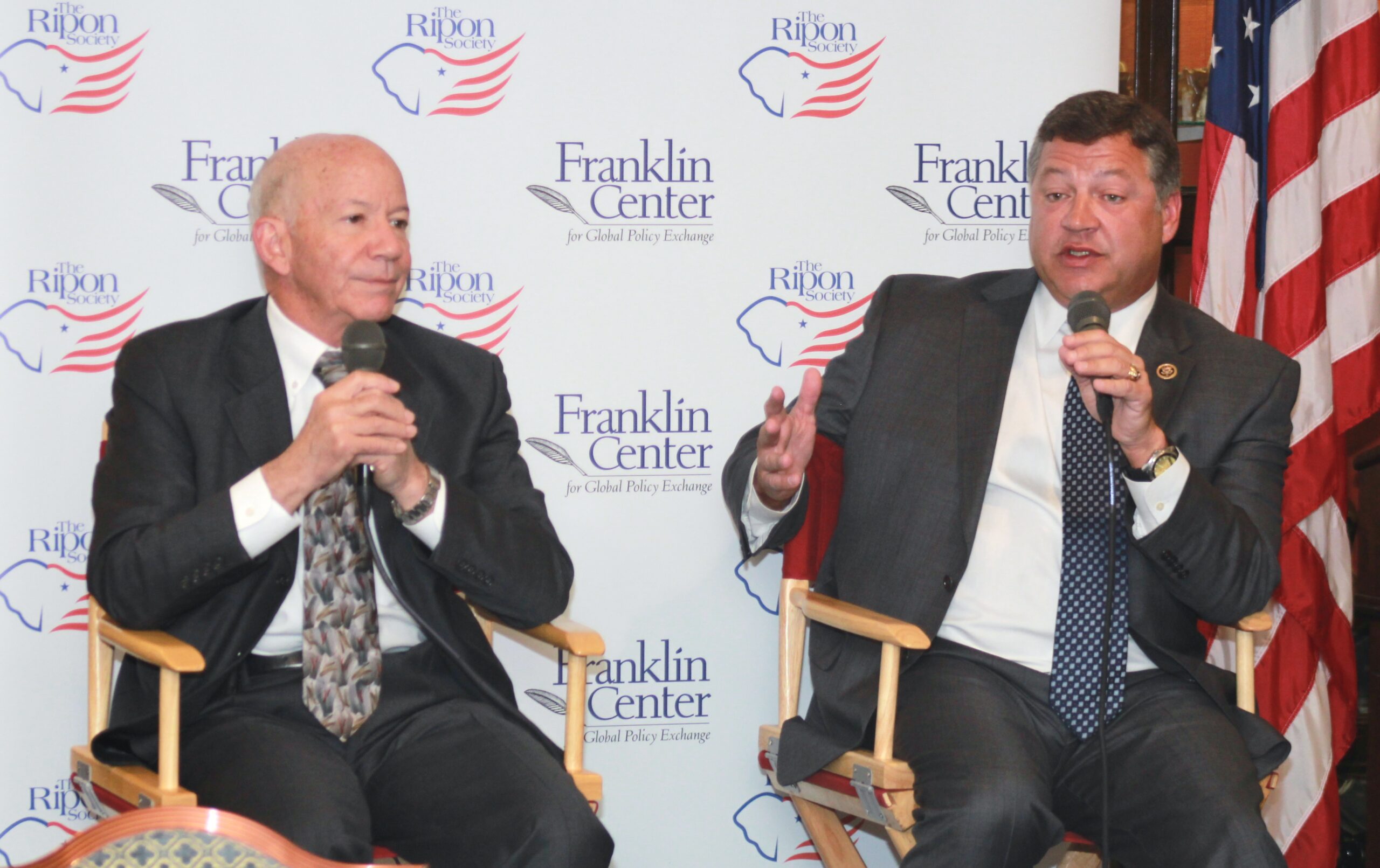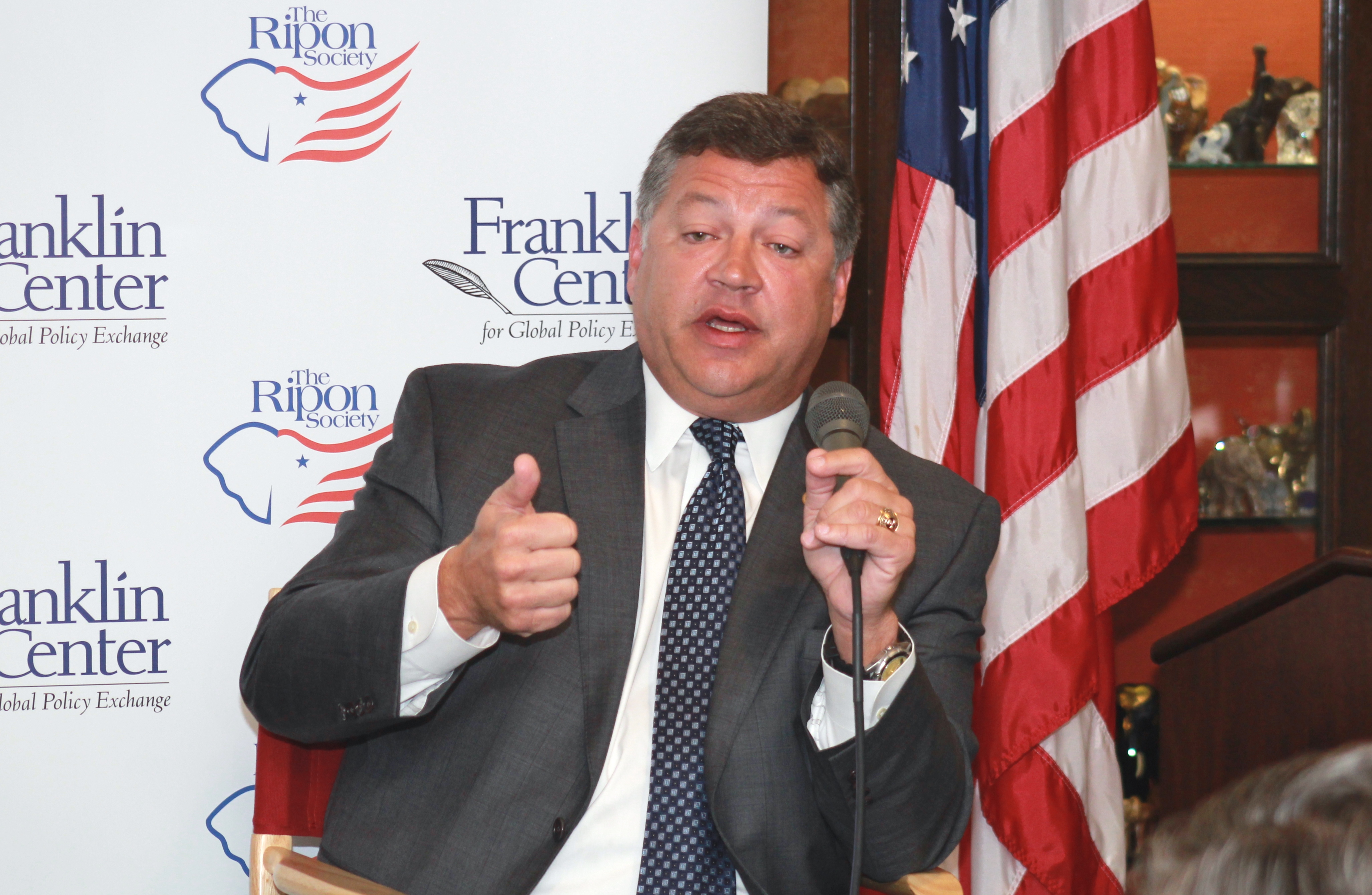 Shuster & DeFazio Spearhead Bipartisan Drive to Rebuild America’s Infrastructure
Shuster & DeFazio Spearhead Bipartisan Drive to Rebuild America’s Infrastructure
WASHINGTON, DC – At a time when Washington is paralyzed by political gridlock, the top Republican and Democratic leaders of the House Transportation and Infrastructure Committee came together yesterday morning to discuss the bipartisan drive they are spearheading to rebuild America’s crumbling bridges and roads – an issue, they note, where political consensus exists, but the source of funding remains in doubt.
The leaders were U.S. Representatives Bill Shuster (R/PA-9) and Peter DeFazio (D/OR-4). Shuster serves as Chairman of the T&I Committee, while DeFazio serves as the panel’s Ranking Member. Appearing at a breakfast discussion hosted by The Ripon Society and Franklin Center, the bipartisan duo made the case that investing in our country’s transportation system was not only needed, but was something the Founders of our country expected and wanted Congress and the President to do.
“From the beginning,” Shuster stated, “the Founding Fathers understood that if you wanted to be a prosperous nation, you had to have a transportation system. Throughout history, I like to point out that the three significant transportation projects in the United States were the transcontinental railroad, the Panama Canal, and the Interstate Highway System. Republican Presidents pushed those projects forward. I don’t know why we’ve given up that mantle as Republicans, but we should claim it back. I hope the next presidential candidate from our side – if he or she lays out five or six principles – I hope one of those principles is to rebuild the transportation system in this country.”

Shuster was elected to Congress in 2000 and became Chairman of the Transportation and Infrastructure Committee in 2012. He stated that one of his panel’s main goals this year is to pass a long-term highway funding bill, and said that he has been in constant contact with the Chairman of the Ways & Means Committee trying to find a solution in that regard. “We’re working very closely with Paul Ryan,” the Pennsylvania Republican said.
Pointing to the May 31st deadline when the current highway funding agreement expires, Shuster added: “We’re running out of time, so we’re probably going to have to pass a short-term bill to get us through the construction season. We’re talking with leadership about that now.”
DeFazio echoed Shuster’s sense of urgency, and ran down a list of reasons why funding needs to be found now.
“America is falling apart, and we need to act,” he declared. “There are 140,000 bridges in the national highway system that need to be repaired or replaced. About 40 percent of the pavement in the national highway system has failed to the point where it has to be totally rebuilt, not just resurfaced. And we have about an $86 billion backlog to bring our transit system up to a state of good repair. That’s not to build out new transit options — that’s just to bring what exists up to a state of good repair. It’s at a point in the nation’s capital where we’re unnecessarily killing people on the Metro system because of the bad state of repair.”
DeFazio was elected to Congress in 1986. The longest serving House member in Oregon’s history and dean of the State’s Congressional delegation, he has served on the T&I panel since taking office and is one of the foremost experts on transportation issues on Capitol Hill. He is also someone who believes that investment in the area of transportation pays dividends in other areas down the road.
“We have to deal with these things – that’s the bad news,” the veteran lawmaker stated, referring to the challenges facing America’s infrastructure and questions over funding. “The good news is we have the strongest ‘Buy America’ provisions of any sector of the government – much stronger than the Pentagon. So if we make these investments, we will put a lot of people back to work, not just in construction and engineering, but in manufacturing and small business. It has a dramatic multiplier effect across the country.”
In a question and answer session after their remarks, Shuster and DeFazio were asked whether they would support indexing the gas tax to inflation as a way to increase funds.

“We haven’t raised the gas tax since ’93,” DeFazio observed. “The estimates are that it’s worth about maybe 60% of what it was in worth at that time because of construction cost inflation. I proposed a number of years ago double indexation. If you go with construction cost inflation, it doesn’t get you a lot — .6 cents a gallon for the next year is what they’re estimating. I looked at double indexation because we’re losing ground not just because of the cost of construction, but because cars are going further and trucks are going further. They’re more efficient. So you’re getting more road miles, but less revenue. So you also need to index to fleet fuel economy. If you do double indexation, that would be about 1.7 cents a gallon a year. I’ve raised this to my colleagues who are somewhat shy about the gas tax. I told them I drove by the gas station on the way to work last week, and the electronic sign went up a nickel. I didn’t see people out there with pitch forks, so I think this is the time to do it. Double indexation with bonding could get us a big bang in a six year bill.”
Shuster disagreed.
“There’s no will in our conference to do that,” he stated bluntly. “The President said four or five years ago that it’s basically not possible to do it. I’m for what’s possible. Paul said he’s going to come up with the money, so my commitment is to a long-term bill. The day after the President signs the bill, we’re going to start talking about fixing the funding, because it’s going to get worse.”
In another question, the Chairman and Ranking Member were asked about driverless technology and its impact on America’s transportation policy – and American drivers – in the future.
“I’ve been in the Google car and the Carnegie Mellon car,” Shuster stated. “It’s amazing technology, and it’s coming. One of the things I’ve proposed is that we put a title in the highway bill to start thinking about how we build a road for that. We need to study it and look at the different materials that need to be in the roads and the sensors. In fact, Pennsylvania has contracted Carnegie Mellon to do just that in a three year study. The roads we build in the next five to ten years will have those kinds of cars on it. They tell me that in probably five to seven years you will be able to go into a showroom and buy a car — it’s going to be a high-end car and you’re going to have to pay $15,000 more for it — but it will be able to drive itself. And they believe within 20 years, 75% of the fleet will be that way. When cars start to talk, congestion will be alleviated and safety will be dramatically improved. So we need to start thinking about that.”
DeFazio concurred.
“With the Google car,” he explained, “it uses LIDAR and it can see when the first car starts to move. So if you had a whole line of cars that were equipped with that technology, all the cars would start to move very smoothly at the same time. Just think about how much congestion you could mitigate. And that’s just one small aspect of it. It’s incredibly exciting technology, and I think we’ll see it in the not too distant future.”
To view the remarks of Chairman Shuster and Ranking Member DeFazio yesterday morning, please click on the link below:
The Ripon Society is a public policy organization that was founded in 1962 and takes its name from the town where the Republican Party was born in 1854 – Ripon, Wisconsin. One of the main goals of The Ripon Society is to promote the ideas and principles that have made America great and contributed to the GOP’s success. These ideas include keeping our nation secure, keeping taxes low and having a federal government that is smaller, smarter and more accountable to the people.



